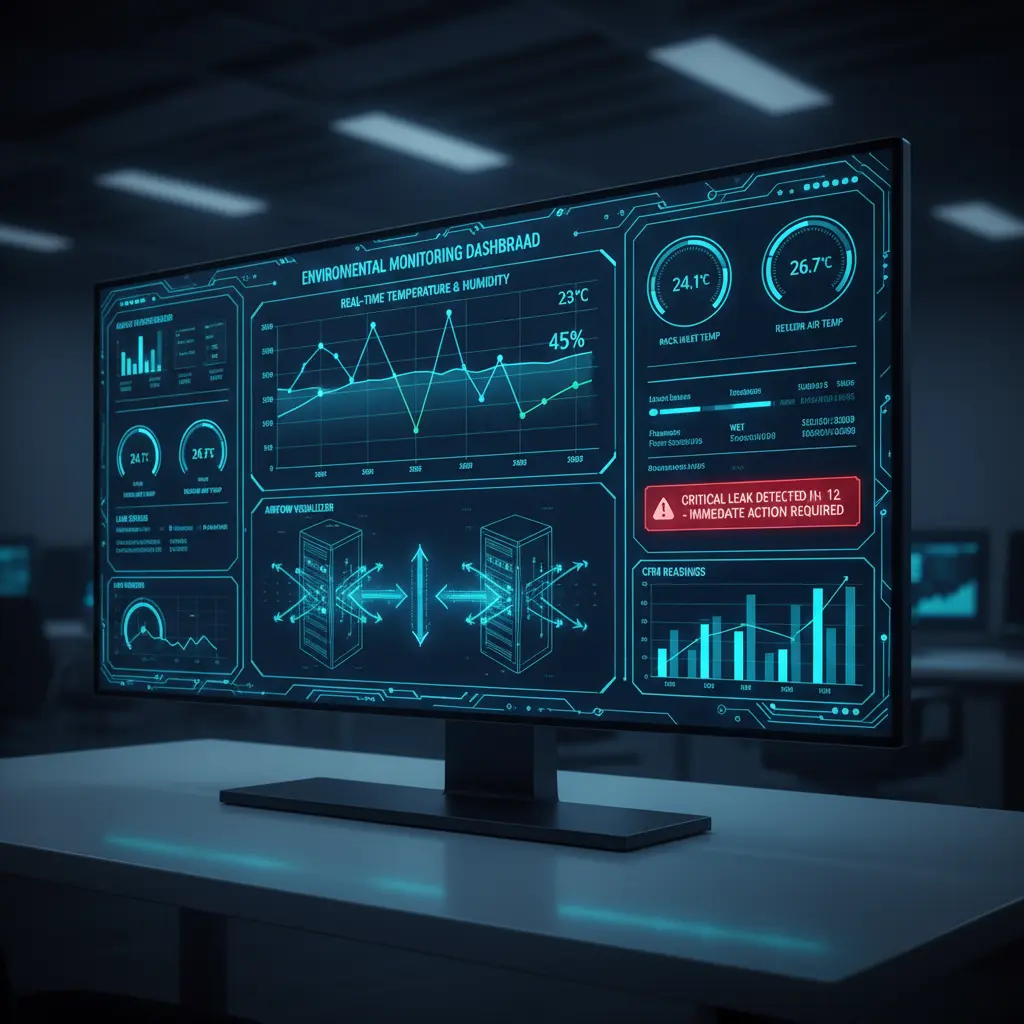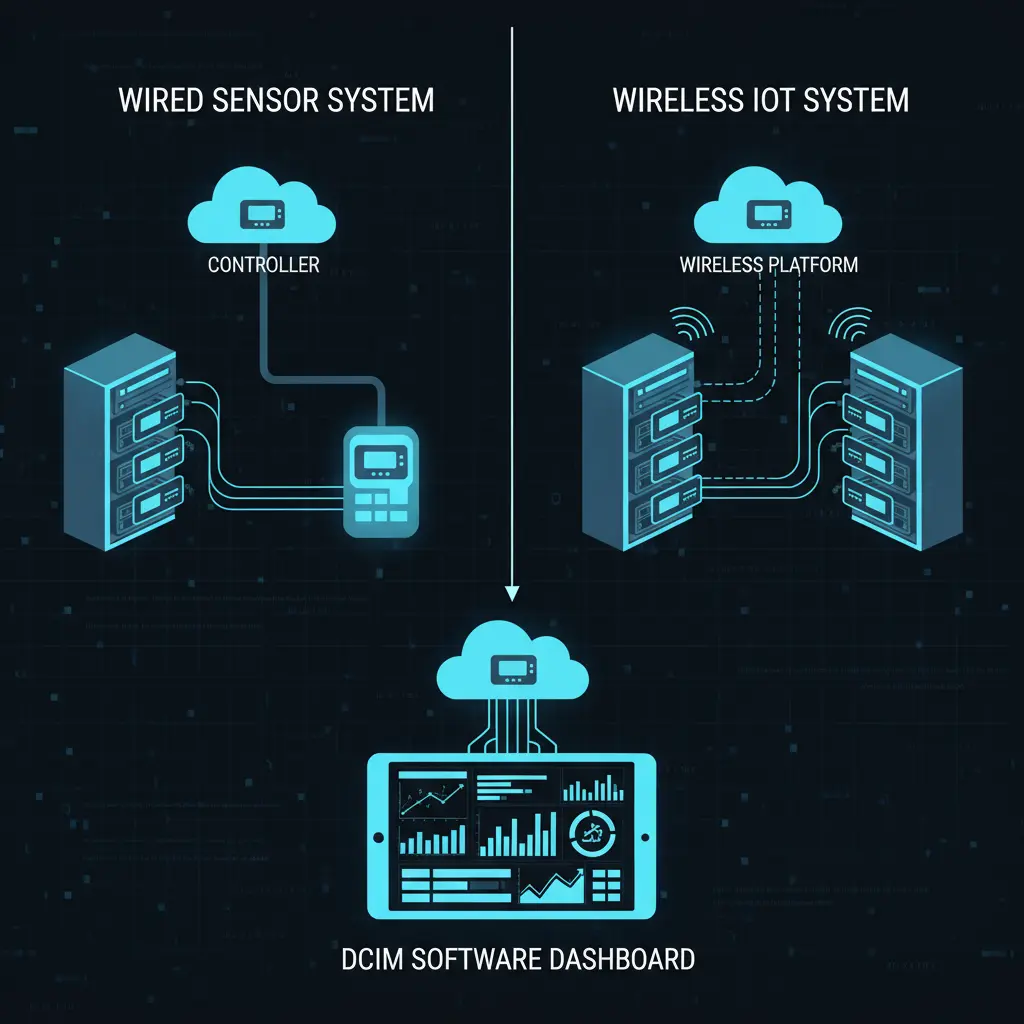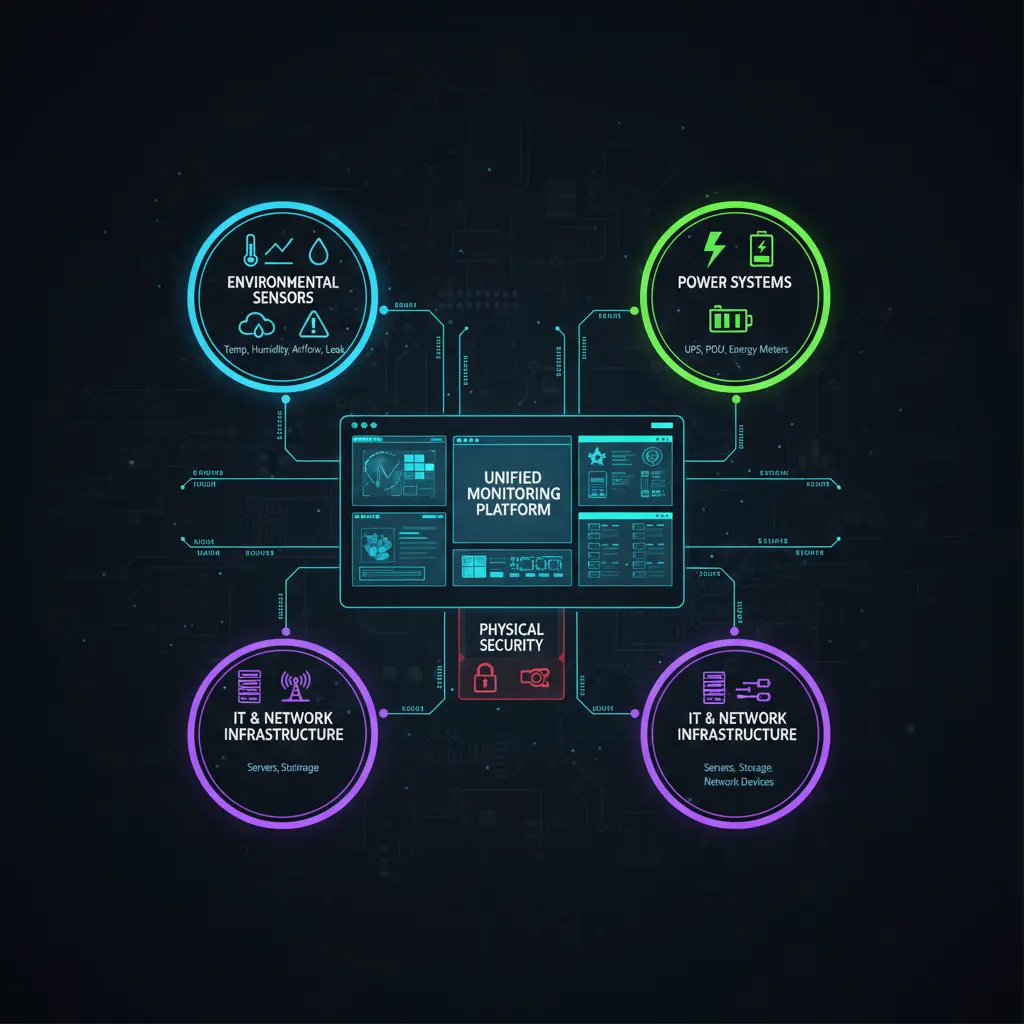Introduction
Modern data centers are more than just rows of server racks and blinking LEDs. They are living, breathing ecosystems where thousands of parts depend on stable environmental conditions. A small rise in temperature, a sudden drop in humidity, or a coolant leak that goes unnoticed can cause a huge amount of downtime.
That’s why data center environmental monitoring systems come in. These systems are like the digital eyes and ears of your building. They keep an eye on the environment and report back to make sure everything is running smoothly.
We’ll look at the following in this full guide:
- What environmental monitoring systems are?
- Why they’re critical to uptime and efficiency
- The key components and types of systems available
- How to choose the right system for your organization
- How they integrate with broader monitoring and temperature management strategies like Server Room Temperature Monitoring
By the end, you’ll know exactly what to look for in data center environmental monitoring systems that works for your business, is the right size, and is easy to use.
What are Data Center Environmental Monitoring Systems?
Data center environmental monitoring systems are a set of sensors, control units, and software that work together to keep an eye on things like temperature, humidity, airflow, and leaks all the time. These systems let IT and facilities staff know when parameters go outside of set limits, which is long before service interruptions happen.
While traditional monitoring might look at how well an application works or how long a network stays up, environmental systems make sure that the physical layer can handle those digital tasks.
A good data center environmental monitoring systems usually have:
- Smart sensors that can tell you the temperature, humidity, and if there is a leak
- Networked gateways that collect data from sensors
- Dashboard or DCIM software for a central view
- AI-powered analytics that find problems before they cause downtime
In short, they turn raw sensory data into useful information.
Why Data Center Environmental Monitoring Systems Matter
A survey by the Uptime Institute in 2023 found that more than 70% of data center outages are caused by problems with the facility that could have been avoided, such as power and cooling failures.
Here’s why it’s important to set up a separate environmental monitoring system:
- Stops thermal overloads – continuous temperature monitoring finds hot spots before equipment breaks down.
- Boosts energy efficiency – Increases energy efficiency by lowering PUE (Power Usage Effectiveness) when cooling is optimized.
- Supports compliance – Helps with compliance: businesses that have to follow ISO 27001, HIPAA, or PCI-DSS can show that they are controlling the environment.
- Extends equipment life – Stable environmental conditions make hardware last longer by reducing wear and tear.
- Integrates with broader visibility platforms – Works with other visibility platforms and connects easily to your data center monitoring systems for full oversight.

Core Components of Data Center Environmental Monitoring Systems
Understanding the anatomy of a monitoring system helps you evaluate which solution aligns best with your facility’s operations.
Sensors and Probes
The heart of environmental monitoring. Sensors measure temperature, humidity, airflow velocity, water presence, and even vibration.
Controllers and Gateways
These consolidate data from sensors and transmit it to management software via Ethernet, Wi‑Fi, or Modbus TCP.
Centralized Management Software
Often part of a DCIM suite, this software visualizes conditions, trends, and alarms.
Alarming and Notification
SMS, email, and API‑based alerts ensure admins know about issues immediately.
Reporting and Analytics
Long‑term data helps with auditing, predictive maintenance, and sustainability tracking.
For deeper insight into selecting physical sensor networks visit our guide to Environment Monitoring System for Data Center.
Types of Data Center Environmental Monitoring Systems
Wired Sensor Systems
Traditional but reliable— hard‑wired sensors connect directly to controllers. Best for large facilities needing precision and low interference.
Wireless IoT Systems
Low‑maintenance and flexible. Ideal for small or edge sites. Wireless nodes transmit data through safe mesh or Wi‑Fi protocols.
DCIM‑Integrated Systems
Platforms such as Sunbird DCIM or Schneider EcoStruxure unify environmental inputs with IT capacity and asset data.
Cloud‑Enabled Solutions
Modern SaaS‑based platforms centralize environmental reporting for multiple distributed data centers—a must for multi‑site operations.
Check Schneider Electric’s EcoStruxure DCIM for examples of scalable environmental management.

How Environmental Monitoring Systems Work
Data Collection – Sensors constantly read environmental variables as part of data collection.
Data Transmission – Gateways gather and send data using secure protocols.
Processing – DCIM software looks at values and trends.
Alert Generation – Alarms go off when readings go above certain levels.
Response & Mitigation – staff take action or automation changes CRAC units or airflow panels on its own.
AI can spot problems that are getting worse, like CRAC fan degradation or airflow imbalance, when it works with predictive analytics.
Key Features to Consider When Selecting a System
- Scalability: Can it grow with additional racks or remote sites?
- Integration: Does it connect to your existing modern data center monitoring systems?
- Alert Customization: Consolidate noise but keep critical alerts prominent.
- Data Logging Duration: Retain historical data for compliance.
- Remote Access: Cloud dashboards allow remote teams to monitor 24/7.
- User Interface: Simple, intuitive visuals shorten training cycles.

Benefits of Implementing the Right Data Center Environmental Monitoring Systems
- Reduced Downtime: Proactive alerts prevent failures.
- Improved Energy Efficiency: Smart control strategies bypass excessive cooling.
- Compliance Simplified: Automatic audit reports for regulatory needs.
- Increased Transparency: Shared dashboards bridge IT and facilities teams.
- Better Planning: Long‑term analytics support capacity and upgrade forecasting.
An introduction to Data Center Environmental Monitoring will emphasize on above ones.
Integration with Broader Monitoring Infrastructure
A stand-alone setup is useful, but when it works with other systems, like data center monitoring frameworks, it gives you a complete picture. By connecting environmental data to network, power, and server analytics, teams can find out exactly why a problem happens, not just where it happens.
This combined method gives your Server Room Temperature Monitoring plan important information that helps keep the right thermal balance.
Outbound reference: Most monitoring vendors follow frameworks like ASHRAE TC 9.9 Thermal Guidelines, which set the recommended temperature and humidity ranges for server inlets.

Common Mistakes to Avoid when choosing Data Center Environmental Monitoring Systems
- Ignoring Sensor Placement: Misplaced sensors create misleading readings.
- Insufficient Alert Tuning: Excessive false alarms desensitize teams.
- Poor Calibration: Failing to recalibrate sensors leads to drifted data.
- Overlooking Edge Locations: Smaller remote facilities often lack monitoring until something breaks.
- Not Testing Failovers: Ensure backup networks deliver alerts even during outages.
Step‑by‑Step Framework for Selecting the Right Solution
- Define Objectives: Compliance? Uptime? Energy savings?
- Map Facility Needs: Rack layout, cooling zones, redundancy paths.
- Compare Vendors: Assess local support, integration APIs, analytics depth.
- Evaluate Costs vs ROI: Balance up‑front investment with long‑term OPEX savings.
- Pilot Deployment: Start small before full rollout.
- Train Teams & Document: Create procedures for response and maintenance.
This structured approach ensures sustainability and alignment with corporate IT strategies.
Conclusion
It’s not just a matter of convenience to choose the right data center environmental monitoring systems; it’s also important for the reliability of modern infrastructure. The best systems turn environmental data into useful information that warns teams before small problems become big ones that cost a lot of money.
These systems work best when they are combined with power and network monitoring. They help with uptime, efficiency, and sustainability goals.
Check out our main solution on Server Room Temperature Monitoring to find out how temperature management fits into this ecosystem. The health of your servers starts with the environment they live in.

